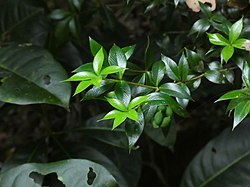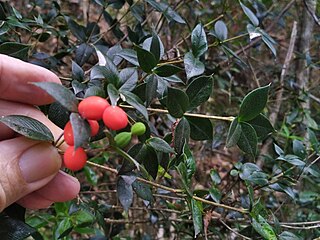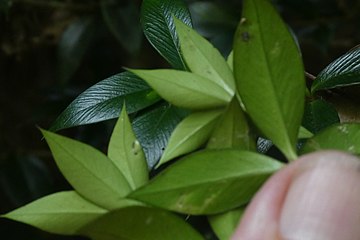Biology:Alyxia oblongata
| Chain fruit | |
|---|---|

| |
Script error: No such module "Conservation status".
| |
| Scientific classification | |
| Kingdom: | Plantae |
| Clade: | Tracheophytes |
| Clade: | Angiosperms |
| Clade: | Eudicots |
| Clade: | Asterids |
| Order: | Gentianales |
| Family: | Apocynaceae |
| Genus: | Alyxia |
| Species: | A. oblongata
|
| Binomial name | |
| Alyxia oblongata | |
| Synonyms[2] | |
| |
Alyxia oblongata, commonly known as the chain fruit, prickly lixy, or prickly Alyxia, is a plant in the dogbane family Apocynaceae endemic to a small part of northeastern Queensland.
Description
Alyxia oblongata is an evergreen shrub growing up to 3 m (9.8 ft) high.[3] The dark glossy green leaves are borne in whorls of three or four on the twigs, and measure about 3.5 by 1 cm (1.38 by 0.39 in).[3] They are elliptic with a sharp, rigid tip and have up to 20 lateral veins.[3]
The flowers are typical of the family, being white with five sepals and petals and a long corolla tube. They measure about 13 mm (0.51 in) long and 17 mm (0.67 in) diameter.[3][4] The fruit are orange/red in colour and may be moniliform, i.e. with the appearance of a string of beads.[3]
Taxonomy
This species was first described in 1928 by the Czech botanist Karel Domin, who published his description in Bibliotheca Botanica. In 1992 the Australian botanist Paul Irwin Forster redefined it as a subspecies of Alyxia ruscifolia, namely A.r. ssp. major, however this combination is no longer accpted by most authorities.[1][2][5]
Etymology
The genus name Alyxia is derived from the Greek language word álysos, "chain", which refers to the chain-like appearance of the fruit. The species epithet oblongata is from "oblong" and again refers to the appearance of the fruit.[6]
Distribution and habitat
The chain fruit is endemic to northeastern Queensland, from near Cooktown to the southern Atherton Tablelands. It grows in rainforest on volcanic soils of various types, at altitudes from 100 m (330 ft) to 1,000 m (3,300 ft).[3][4]
Conservation
This species is listed by the Queensland Department of Environment and Science as least concern.[7] (As of January 2023), it has not been assessed by the IUCN.
Gallery
References
- ↑ 1.0 1.1 "Alyxia oblongata". Centre for Plant Biodiversity Research, Australian Government. https://id.biodiversity.org.au/name/apni/84825.
- ↑ 2.0 2.1 2.2 "Alyxia oblongata Domin". Royal Botanic Gardens, Kew. https://powo.science.kew.org/taxon/76735-1.
- ↑ 3.0 3.1 3.2 3.3 3.4 3.5 "Alyxia oblongata". Centre for Australian National Biodiversity Research (CANBR), Australian Government. 2020. https://apps.lucidcentral.org/rainforest/text/entities/Alyxia_oblongata.htm.
- ↑ 4.0 4.1 Forster, P.I. (2020). "Alyxia ruscifolia ssp. major". Australian Biological Resources Study, Department of Climate Change, the Environment and Water: Canberra. https://profiles.ala.org.au/opus/foa/profile/Alyxia%20ruscifolia%20subsp.%20major.
- ↑ "Alyxia ruscifolia subsp. major". World Flora Online Consortium. http://www.worldfloraonline.org/taxon/wfo-0000956233.
- ↑ Cooper, Wendy; Cooper, William T. (June 2004). Fruits of the Australian Tropical Rainforest. Clifton Hill, Victoria, Australia: Nokomis Editions. p. 33. ISBN 9780958174213. https://www.nokomis.com.au/product/nokomis-published-books/fruits-australian-tropical-rainforest/.
- ↑ "Species profile—Alyxia oblongata". Queensland Government. 2022. https://apps.des.qld.gov.au/species-search/details/?id=22371.
External links
- View a map of historical sightings of this species at the Australasian Virtual Herbarium
- View observations of this species on iNaturalist
- View images of this species on Flickriver
Wikidata ☰ Q15390747 entry
 |





